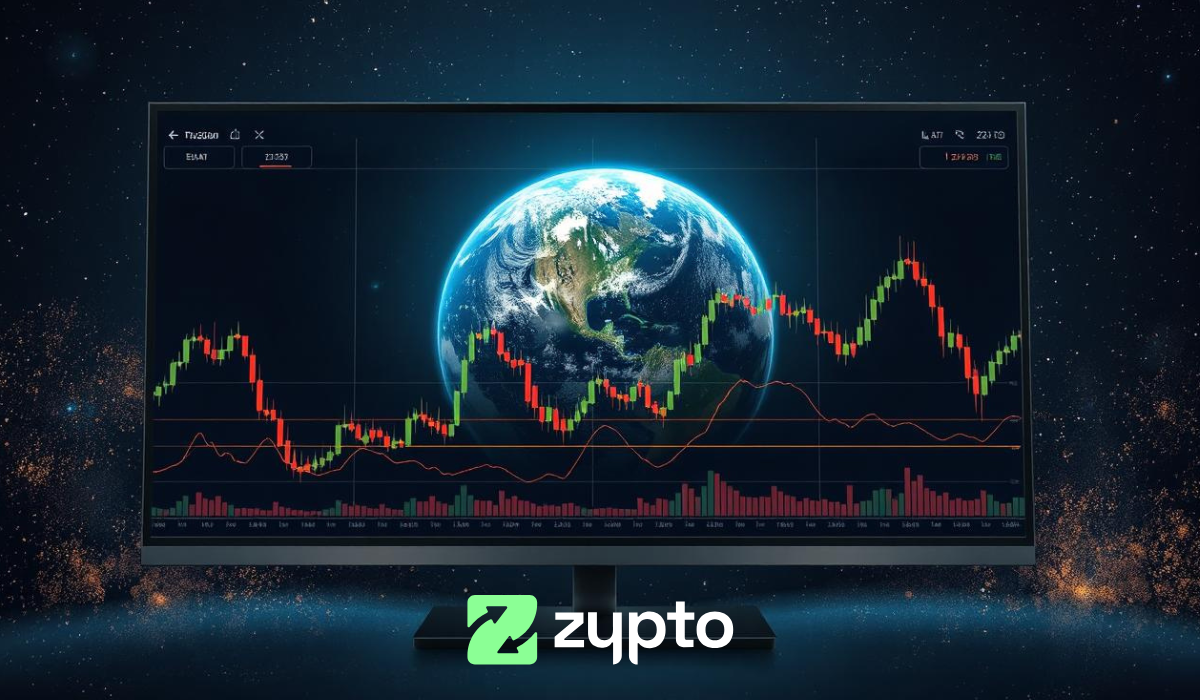Imagine a digital marketplace with no human vendors, yet transactions happen seamlessly, and prices adjust in real time. That’s the beauty of an Automated Market Maker (AMM).
The blockchain space equips users with the latest DeFi trends that put them in the driver’s seat in the financial space. An Automated Market Maker is a classic example of such developments. It enables millions of users to trade without needing a centralized entity.
Today’s post discusses the concept of AMMs and how they work. It also explores how liquidity pools work and how you can participate as a liquidity provider (LP). Without further ado, let’s dive right in.
What is an Automated Market Maker?
An Automated Market Maker is a smart contract and algorithm that allows users to trade digital assets in a decentralized exchange (DEX).
It can be thought of as a vending machine, as it provides direct trading without needing a counterparty to match orders—every activity is automated. An AMM differs from a traditional order book used by centralized exchanges where buyers and sellers list their prices.
Automated Market Makers use smart contracts—self-executing codes on the blockchain—to automate the whole process. They also rely on liquidity pools, which allow instant peer-to-peer trading, making the entire process decentralized. When combined, they remove intermediary activity and foster a permissionless environment.
How Does an Automated Market Maker Work?
Having understood the concept of an AMM, you may wonder why it’s crucial in decentralized finance. The truth is traditional exchanges often grapple with limited liquidity. Newer or less popular tokens mostly face this reality. However, AMMs address this issue by developing liquidity pools.
A liquidity pool is basically the collection of crypto held in a smart contract. To better understand its role, let’s use Zypto (ZYPTO) and Tether (USDT) as hypothetical examples. The ratio of these assets in this pool determines the price of each.
So, this liquidity pool receives $ZYPTO and $USDT tokens from willing investors and locks them in a smart contract. These investors become liquidity providers, earning a share of trading fees when traders interact with the ZYPTO/USDT pool.
Now that we have a ZYPTO/USDT pool, AMMs use a constant product formula. For instance, Uniswap, a popular AMM, has a formula of x * y = k. In this formula, x represents the amount of ZYPTO, y represents the amount of USDT, and k is a constant value.
If the pool holds 1,000 Zypto tokens and 10,000 USDT, then k becomes 1,000,000 {1,000 Zypto (x) X 10,000 USDT (y)}. This k is a constant balance of assets in this liquidity pool and determines the price of each asset. In this scenario, the price of 1 Zypto token would be 100 USDT (k / x)
Suppose the current price of $ZYPTO is $100 (1,000,000/ 10,000), and 500 Zypto tokens were bought from the pool. In that case, $ZYPTO’s price becomes $200 (1,000,000/500). Therefore, as more $ZYPTO is purchased from the pool, the remaining amount decreases, thus increasing the token’s price.
Notably, this is a hypothetical case. Factors like slippage, trading fees, and Total Value Locked (TVL ) may affect the price and ratio of each asset in the pool.
Four Popular Automated Market Makers
Some of the well-known AMMs include Uniswap, Balancer, Kyber, and Curve. Each platform has unique features and improvements on the basic AMM model. Let’s consider them:
Uniswap
Uniswap is the most popular DEX out there, offering an open and accessible marketplace. Its AMM mechanism calculates token prices based on the ratio of tokens in liquidity pools.
Balancer
Balancer is another top AMM crypto exchange similar to Uniswap but with more features. It includes custom pool ratios, multi-token pools, and dynamic pool fees. The multi-token pools act like a crypto index, allowing for diverse investments.
Kyber Network
Kyber Network is one of the oldest AMM protocols. Professional market makers manage its liquidity pools, offering control during volatility. However, Kyber doesn’t rely solely on automated algorithms and has some restrictions on liquidity pool access.
Curve Finance
Curve Finance focuses on trading stablecoins, ensuring minimal fees and reduced slippage. Its specialization in stablecoins makes it unique among AMMs.

Pros of an Automated Market Maker
AMMs have several benefits that make them super appealing in the DeFi world. Let’s consider a few perks:
Enhanced Liquidity and Trading Efficiency
Due to the nature of AMMs being reliant on liquidity providers, much more liquidity can be offered compared, especially to support less popular tokens. This way, you can easily trade without waiting for a buyer or seller to match your orders.
Reduction in Dependence on Counterparties
In traditional exchanges, one would require a counterparty to trade. With AMMs, you are trading directly with the pool—there is no need for someone to execute your trades.
Lower Barriers to Entry for Liquidity Providers
Anyone can be a market maker. You don’t need significant capital or special rights to do so. Just add your tokens to the pool and start earning trading fees.
24/7 Market Availability
AMMs operate round the clock. You can trade anytime, anywhere, without worrying about market hours.
Drawbacks to Using AMMs
Of course, there are some downsides to AMMs. Here are some risks you should be aware of:
Impermanent Loss
It occurs when the price of your tokens in the pool changes after you deposit them. Thus, they become less valuable than if you had just held them in your wallet. This loss is “impermanent” because it only becomes real if you withdraw your tokens.
Slippage
This is the anticipated price of a trade versus the actual price. A large trade order in a low liquidity pool may result in big price changes. This makes it challenging for traders to execute such trades without incurring losses, no matter how little they may seem.
Smart Contract Risks
Since AMMs are powered by smart contracts, they’re only as secure as the code they’re written in. Bugs or exploits in the code can lead to massive losses, as seen in different DeFi hacks.
Variations of AMMs
The world of AMMs is constantly evolving, with newer variants making them even more efficient and user-friendly. They also address existing challenges and cater to diverse market needs. Here are a few of them:
Dynamic Pricing Formulas
Platforms like Balancer introduce more complex formulas that adjust pool weights based on supply and demand. This mitigates impermanent loss for liquidity providers.
Specialized AMMs
Certain AMMs are designed for specific types of assets. Curve, for instance, utilizes specialized algorithms to optimize stablecoin swaps. This reduces price slippage between pegged assets.
Hybrid Models
Kyber Network’s Dynamic Market Maker (DMM) combines AMM functionalities with order book elements to enhance liquidity and price discovery.
Layer 2 Solutions
Scaling limitations on the blockchain can hinder the performance of an automated market maker. Some AMMs adopt layer two scaling solutions like Polygon or zk-Rollups to tackle this issue and facilitate faster and cheaper transactions.
Differences Between Centralized Exchanges and an Automated Market Maker
Users depend on two types of exchanges: Centralized Exchanges (CEXs) and Decentralized Exchanges. CEXs are famous for their large trading volumes and liquidity. Nevertheless, they are prone to hacks and face centralized control issues.
Conversely, DEXs leverage AMMs to cut out the intermediary between the two traders. They run on smart contracts to facilitate trades. Here are a few standout differences to these exchanges.
| Features | CEX | AMM |
| Control | Operated by a central authority | Decentralized, controlled by smart contracts |
| Liquidity | Generally higher due to a larger user base and institutional involvement | Depends on liquidity providers |
| Trading Volume | Typically high, attracting more traders | Varies based on the number of liquidity providers and user participation |
| Security Risks | Single point of failure, prone to hacks | Vulnerable to smart contract bugs and exploits |
| Fund Control | Held by the exchange | Users retain control of their funds |
| Fees | This may include trading fees, withdrawal fees, etc | Generally lower, with fees primarily for network transactions |
| Price Determination | Order book determines prices | Prices are set algorithmically based on liquidity pool ratios |
| Examples | Binance, Coinbase, Kraken | Uniswap, Curve, Balancer |
Regulatory and Compliance Considerations for AMMs
Things can get tricky when regulating an Automated Market Maker. Traditional financial systems, like those regulated under MiFID 2 in Europe, classify platforms with a central order book as Multilateral Trading Facilities (MTFs) or regulated markets.
However, AMMs don’t fit neatly into these categories. The European Securities and Markets Authority (ESMA) has noted that decentralized platforms, which rely on self-executing codes rather than a central operator, present unique challenges.
AMM protocols aren’t covered under the Pilot Regime Regulation (EU 2022/858), which focuses on market infrastructures using distributed ledger technology (DLT). If AMMs deal with DLT securities, they might need a license to operate as DLT MTFs.
Yet, identifying who should hold this license is complicated due to the decentralized nature of these platforms. As DeFi becomes more mainstream, we can expect more detailed and stringent regulations.
What To Expect in The Future
The future of automated market makers looks bright, with many exciting developments on the horizon. Innovations like dynamic pricing, hybrid models, and Layer 2 solutions will continue to improve AMMs’ efficiency and user experience.
As centralized institutions explore blockchain technology, we might see more integration between DeFi and traditional finance. This could lead to new opportunities and increased adoption of AMMs.
Interestingly, innovative solutions like Zypto Pay have emerged to provide more accessibility by allowing merchants to accept crypto payments. Once funds are received, they can be withdrawn instantly to any blockchain address, converted to fiat, and sent to a bank account through third-party integrations.
As technology and user experiences evolve, AMMs and revolutionary platforms like Zypto Pay will be at the forefront of creating a more decentralized and equitable trading system.
What do you think about Automated Market Makers and their impact on crypto trading? Let us know in the comments.

FAQs
What is an example of an automated market maker?
Uniswap is a prominent example of an automated market maker (AMM). It is a decentralized exchange (DEX) that uses smart contracts to facilitate trading without the need for an order book.
How does an automated market maker work?
An automated market maker works by using smart contracts to create liquidity pools where users can trade assets.
Instead of matching buyers and sellers, AMMs use mathematical formulas to set the price of assets based on supply and demand within the pool. Users can trade directly against the liquidity pool, and liquidity providers earn fees for their contributions.
Who created the first automated market maker?
Vitalik Buterin proposed the concept of automated market makers, but Uniswap, launched by Hayden Adams in 2018, is credited as the first successful implementation of an AMM on the Ethereum blockchain.
What is the difference between AMM and Dex?
An AMM is a type of DEX (Decentralized Exchange). While traditional DEXs use order books to match buyers and sellers, AMMs use liquidity pools and mathematical formulas to facilitate trading.
AMMs provide continuous liquidity and typically offer a simpler trading experience, whereas order book-based DEXs may provide more control over trade execution and pricing.






















Another great read, nicely written and informative.